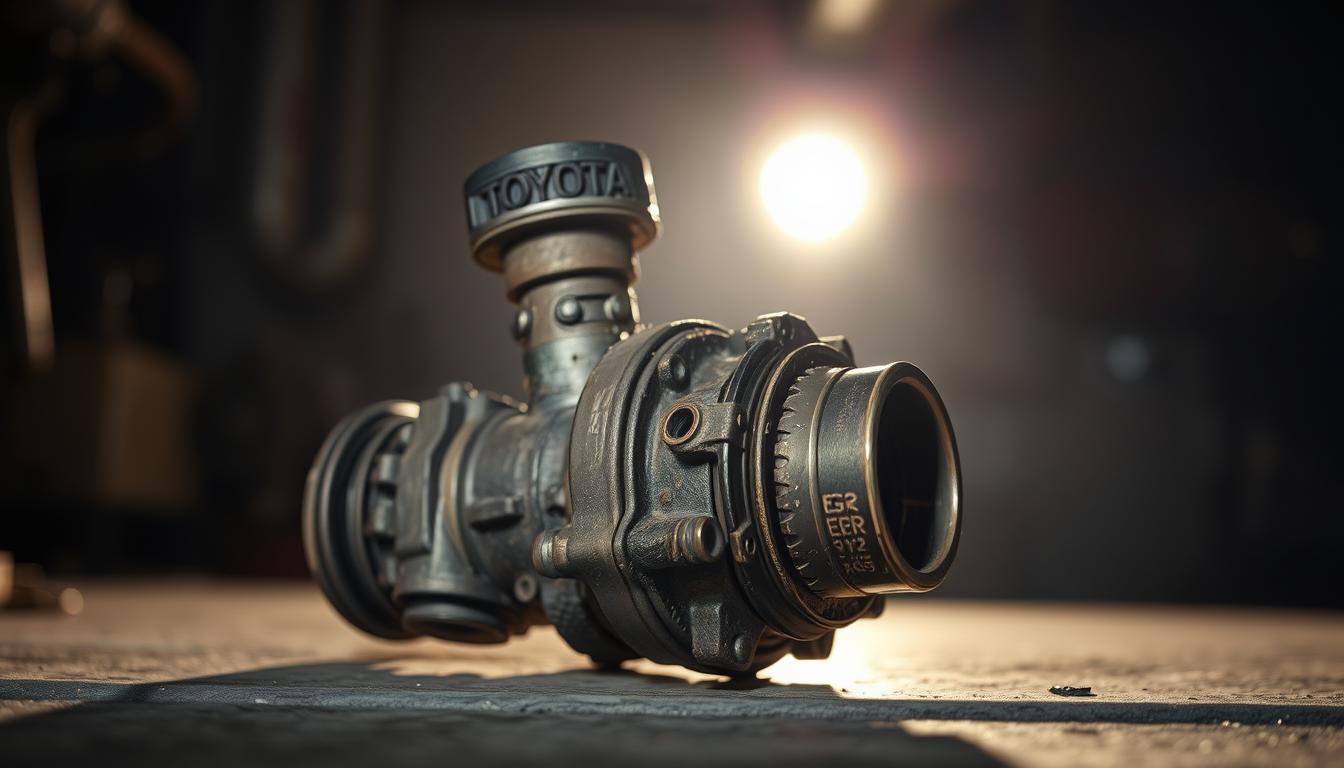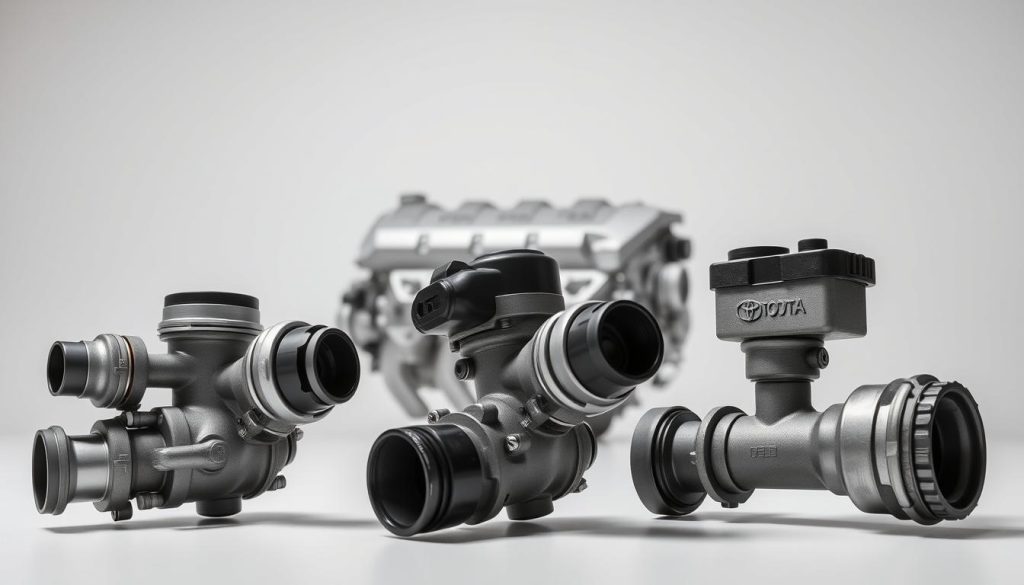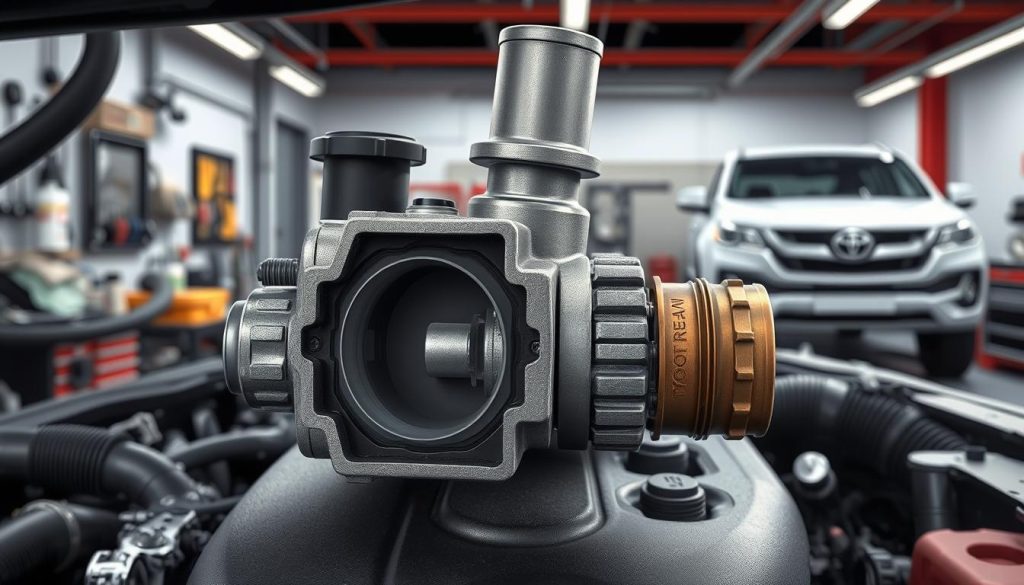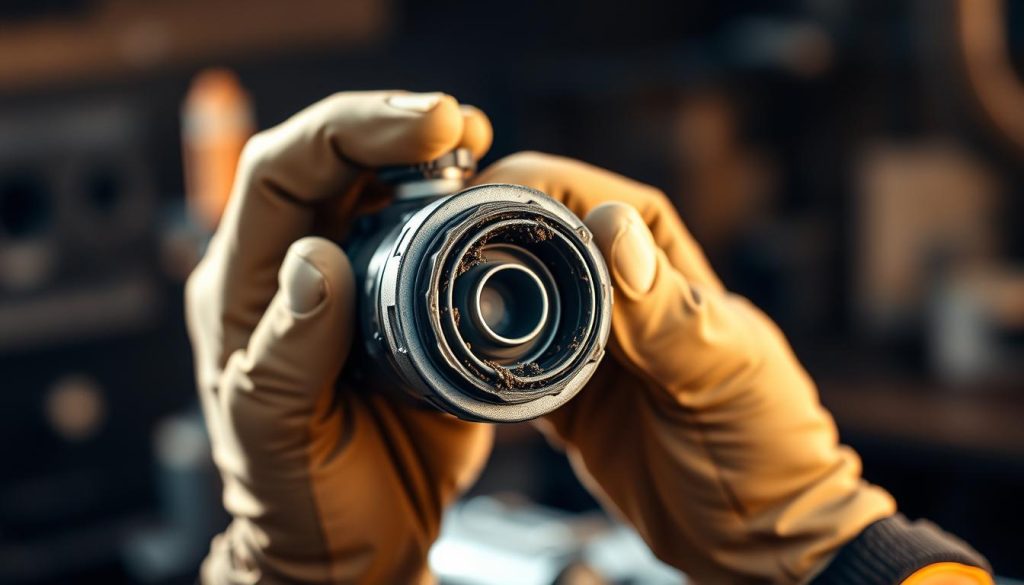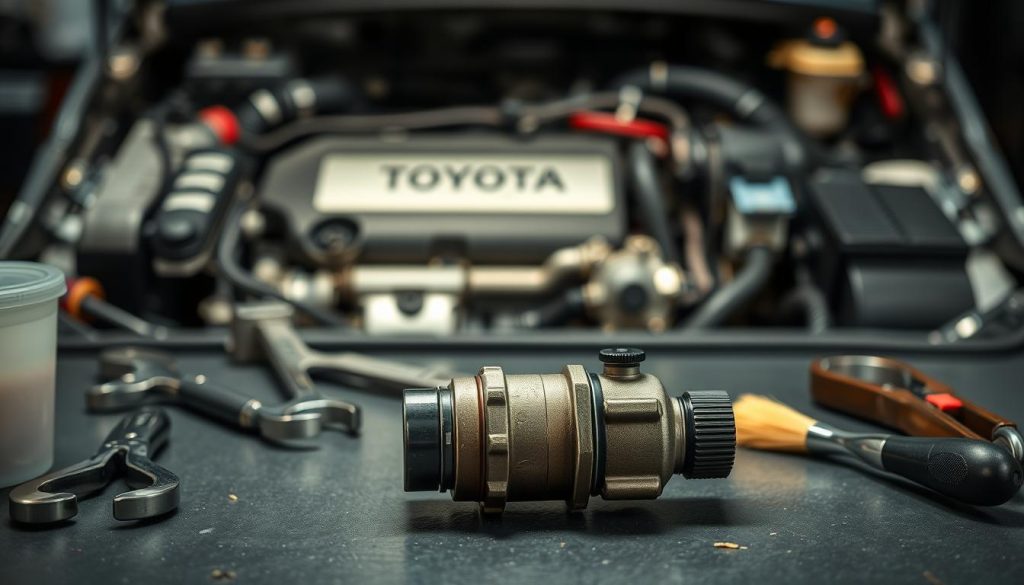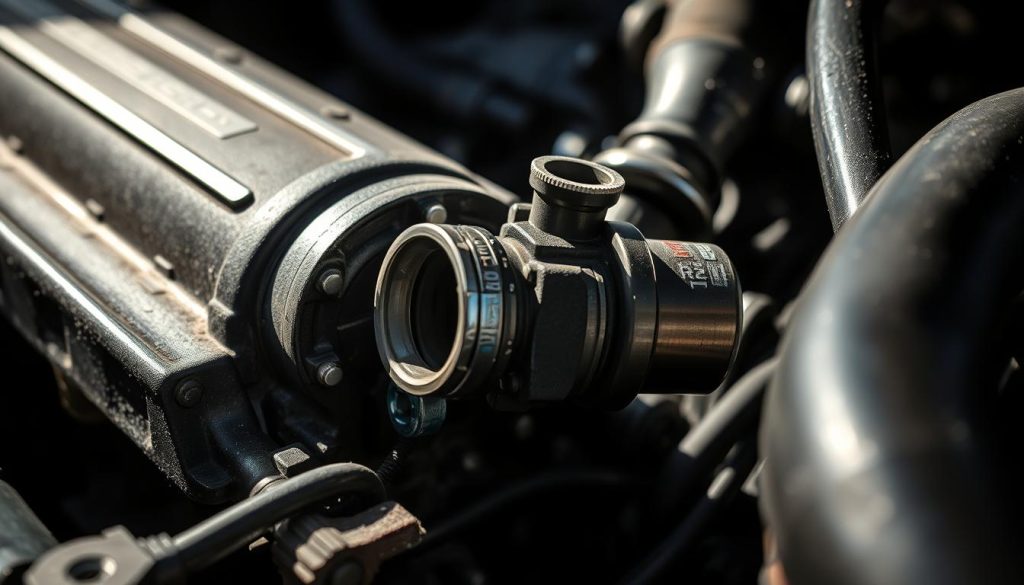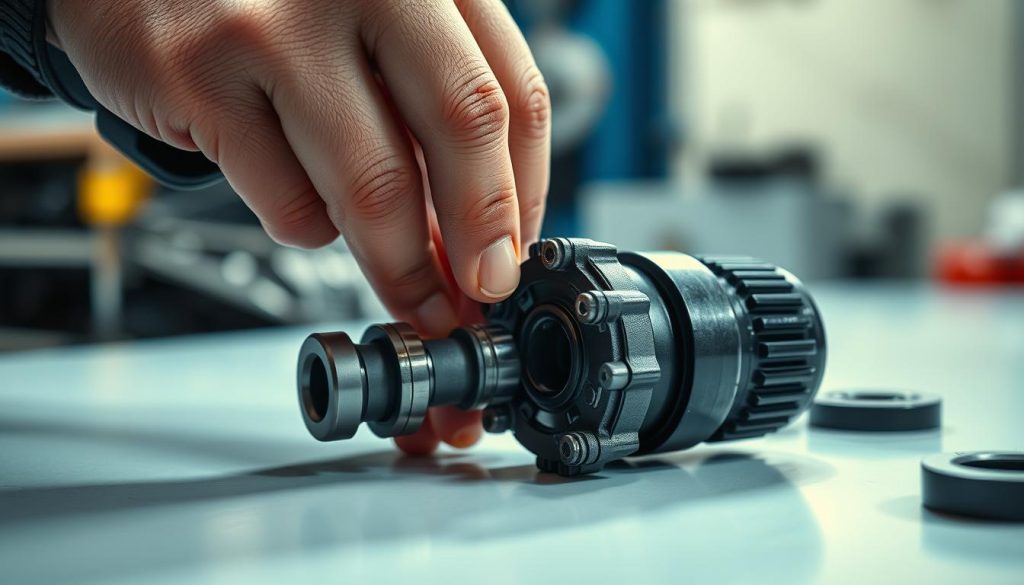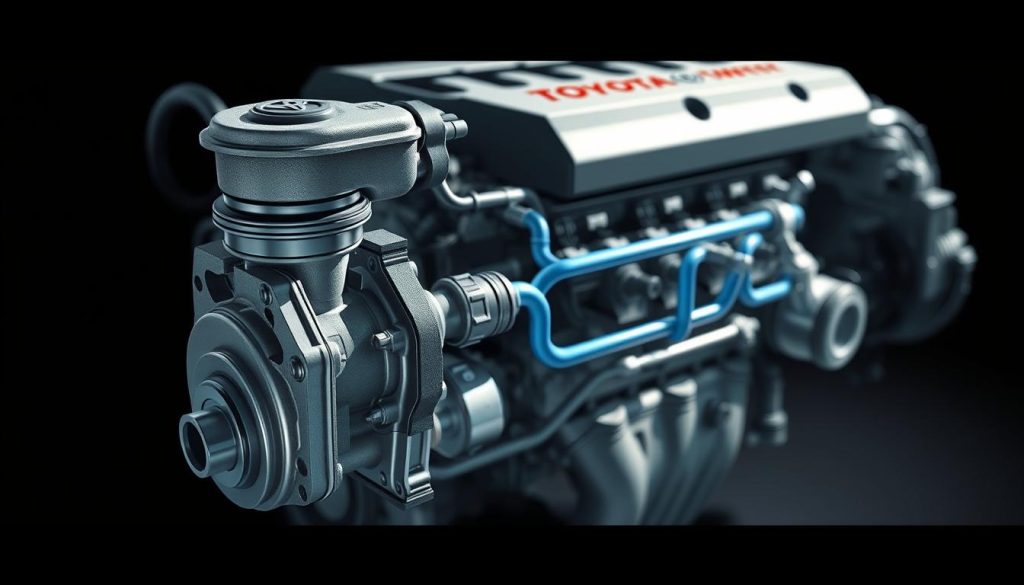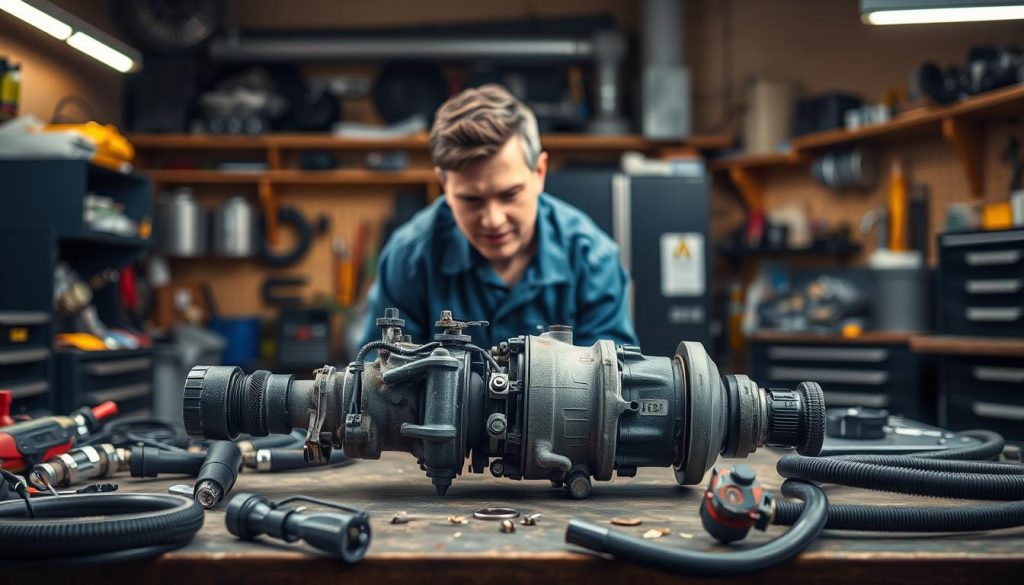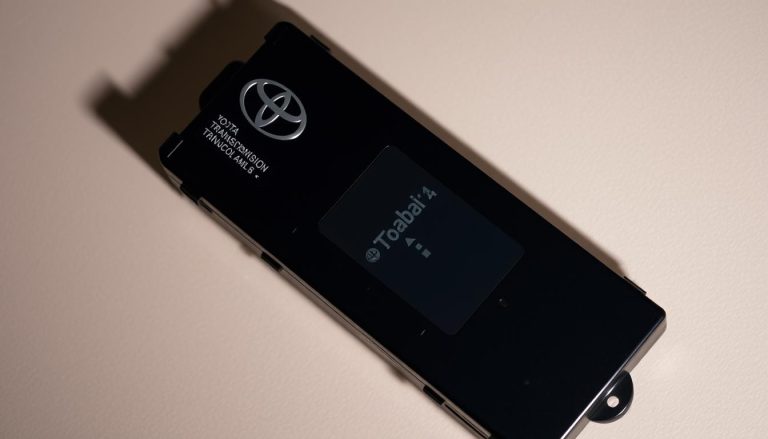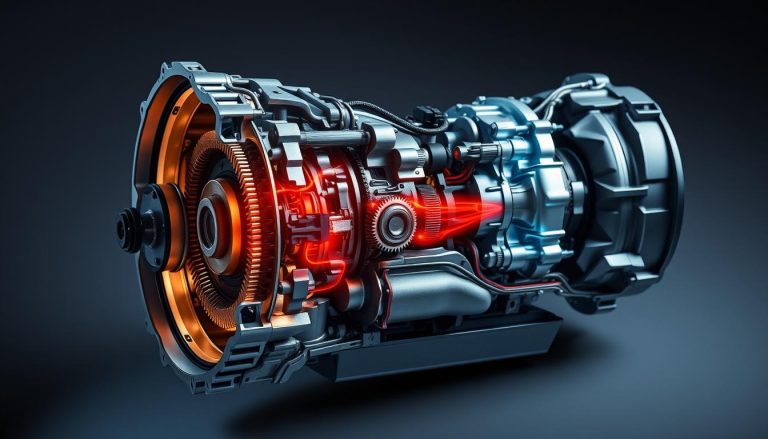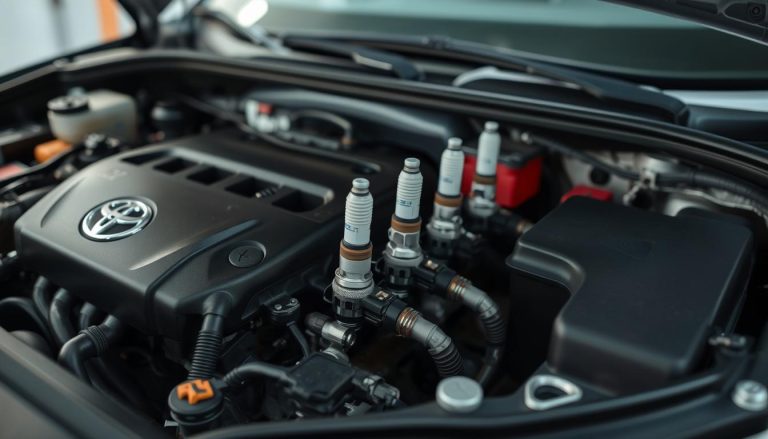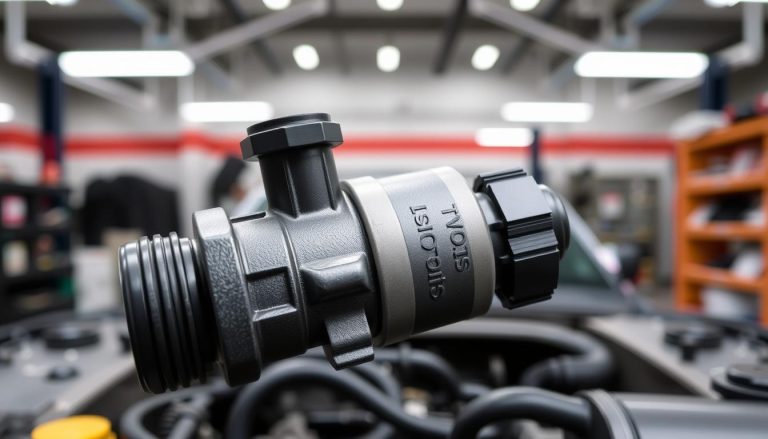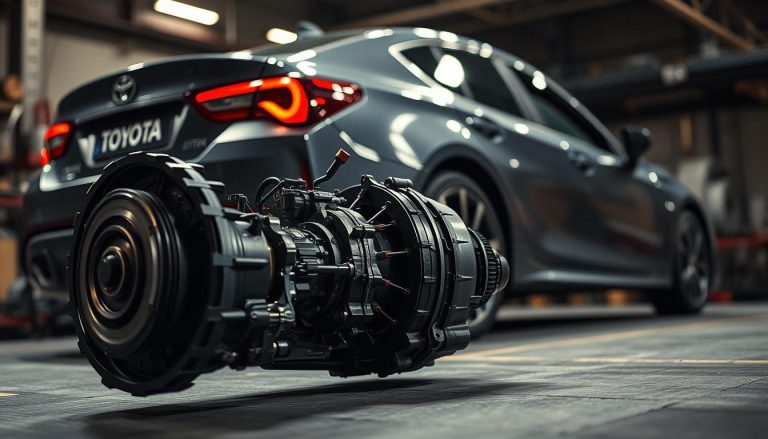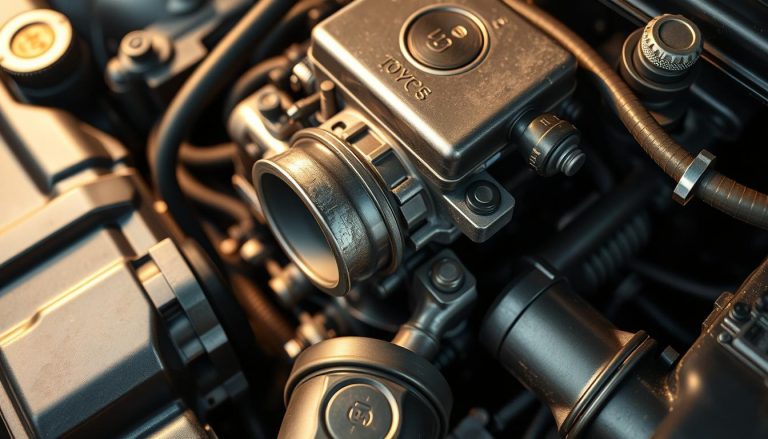Troubleshoot Toyota EGR Valve Problems
Fixing Toyota EGR valve issues is key to keeping your car running well and meeting environmental rules. The EGR valve is important for cutting down emissions and making your engine more efficient. Knowing how it works, spotting common problems, and using the right fixes can help your Toyota perform at its best.
This guide covers the EGR system in detail. It explains common issues and offers practical ways to fix EGR valve on Toyota cars. It’s useful for both experienced mechanics and car lovers. You’ll learn how to handle Toyota EGR system repair with ease.
Understanding the Function of the Toyota EGR Valve
The Toyota EGR (Exhaust Gas Recirculation) Valve is key in modern cars. It helps cut down emissions and boosts engine performance. Knowing how it works can help keep your Toyota running well for a long time.
What is the EGR Valve?
The EGR valve sends some exhaust gases back into the engine’s intake. This lowers the combustion temperature. It also cuts down harmful nitrogen oxide (NOx) emissions.
This action fixes common EGR valve problems. It makes sure exhaust gases are handled right in the engine.
Importance in Emission Control
The Toyota EGR valve importance is huge. It helps control NOx emissions, a big air pollutant. This meets strict environmental rules and makes your car eco-friendly.
Role in Improving Engine Efficiency
A working EGR valve boosts engine efficiency. It lowers the engine’s combustion temperature. This makes your car use fuel better and run smoother.
Fixing EGR valve issues early can really improve your engine’s performance. It makes your car last longer and run better.
Types of EGR Valves in Toyota Vehicles
In Toyota cars, the EGR valve is key for cutting down emissions and boosting fuel efficiency. There are various EGR valve types for different engines and tech levels. The main ones are vacuum-operated and digital EGR valves.
Vacuum-Operated EGR Valves
The vacuum-operated EGR valve is found in older Toyotas. It uses the engine’s vacuum to control exhaust gas flow back into the intake. When vacuum pressure goes up, the valve opens, letting gases in. This cools the engine and cuts down on harmful emissions.
These valves are simple and reliable but need regular checks to work right. Clogs can stop them from doing their job well.
Digital EGR Valves
Modern Toyotas have digital EGR valves. These use electronics for better control over exhaust gas. Sensors and actuators adjust gas flow in real-time based on engine data.
This leads to cleaner emissions and better fuel use. Digital controls make these valves more reliable and efficient than older types.
| Feature | Vacuum-Operated EGR Valve | Digital EGR Valve |
|---|---|---|
| Control Mechanism | Engine manifold vacuum | Electronic control |
| Primary Use | Older Toyota models | Modern Toyota vehicles |
| Precision | Moderate | High |
| Maintenance Needs | Regular cleaning | Low |
Common Toyota EGR Valve Problems
Toyota EGR valves can face several common issues. Knowing these problems helps you keep your car running well and meeting emissions standards. We’ll look at three main problems: carbon buildup, electronic faults, and vacuum line malfunctions.
Carbon Buildup Issues
EGR valve carbon buildup is a big problem. Carbon deposits can block the EGR valve, making it less effective. This can cause more emissions and lower engine performance.
Electronic Faults
EGR electronic faults are also common. The EGR valve’s electronic control is key to managing exhaust gas. If it malfunctions, the valve won’t work right, leading to poor performance and failing emissions tests.
Vacuum Line Malfunctions
Vacuum line malfunctions can also hurt the EGR valve’s performance. Leaks or blockages in vacuum lines can mess up exhaust gas flow. This can lead to worse performance and more emissions. Regular checks can catch and fix these problems early.
Symptoms of a Failing Toyota EGR Valve
A bad Toyota EGR valve can cause many problems. It’s important to spot these signs early. This way, you can fix issues before they get worse.
Check Engine Light
The check engine light is a common sign of a bad EGR valve. It’s like a warning light that tells you something’s off. Fixing this light quickly can stop bigger engine problems later.
Rough Idle and Stalling
A rough idle or car stalling can mean EGR valve trouble. A faulty valve messes with the engine’s air-fuel mix. This can cause the car to idle poorly or stall often. These signs are serious and can hurt your car’s performance.
Poor Acceleration
Poor acceleration is another sign of a failing EGR valve. If your car doesn’t pick up speed when you press the gas, it might be the EGR valve’s fault. This makes the engine take in less air, leading to less power.
Increased NOx Emissions
The EGR valve helps lower nitrogen oxides (NOx) emissions. If it fails, NOx emissions go up. This harms the environment and can cause you to fail emissions tests.
Spotting these symptoms helps keep your car running well. It makes driving safer and more enjoyable.
How to Troubleshoot Toyota EGR Valve Problems
Start by noticing signs of trouble with your Toyota EGR valve. Look out for an illuminated check engine light, less engine power, and odd emissions. Spotting these signs helps you figure out what’s wrong.
To find the problem, you’ll need an OBD-II scanner. These tools show you specific error codes related to the EGR valve. First, plug the scanner into your car’s port and get any stored codes.
With the codes in hand, do a manual check. Look for wear and tear, like carbon buildup in the valve. This is key because carbon can really mess with how the valve works.
After spotting the problem, clear the fault to fix it. This might mean cleaning or replacing the EGR valve. Make sure the valve and its paths are clear to boost engine power and cut down emissions.
In short, fixing a Toyota EGR valve problem needs both electronic checks and hands-on inspections. Catching symptoms early and using the right tools helps fix issues fast. This keeps your car running smoothly.
Steps to Clean a Toyota EGR Valve
Cleaning the Toyota EGR valve is key to keeping your car running well. It helps your vehicle run smoothly and cuts down on harmful emissions. Here’s a detailed guide to help you clean it right.
Required Tools and Materials
- EGR valve cleaner spray
- Screwdrivers (both flathead and Philips)
- Gasket kit
- Rags or paper towels
- Rubber gloves
- Safety goggles
Cleaning Process
First, make sure the engine is off and cool. This step is to avoid any injuries.
- Find the EGR valve, usually on the engine block near the intake manifold.
- Turn off the battery to avoid electrical issues during cleaning.
- Use screwdrivers to remove the bolts holding the EGR valve. Keep the bolts safe to avoid losing them.
- Take off the EGR valve and check for carbon build-up or blockages.
- Use EGR valve cleaner spray in the valve openings to break down carbon. Wipe off the loosened particles with a rag.
- Make sure all ports, passages, and the valve are clean. If needed, spray and wipe again.
- Let the valve dry completely. Then, put it back on with a new gasket for a tight seal.
- Reconnect the battery and start the engine to test the EGR valve.
Regular cleaning of the Toyota EGR valve prevents problems and boosts your car’s life. Keeping the EGR system in good shape improves engine performance and controls emissions.
Replacing a Faulty Toyota EGR Valve
Many Toyota owners face issues with their EGR valves. If you’re thinking about replacing Toyota EGR valve, it’s important to know the details. A bad EGR valve can hurt your engine’s performance, making it less fuel-efficient and increasing emissions.
To start, you need to figure out if the EGR valve is the problem. After confirming, you must buy the right EGR valve for your Toyota. The cost of Toyota EGR valve replacement depends on your car model and the type of valve.
Here’s a simple guide to replace your Toyota EGR valve:
- Disconnect the battery: Begin by disconnecting your car’s battery to avoid any electrical problems.
- Locate the EGR valve: The EGR valve is usually near the engine’s top or side, connected to the intake manifold.
- Remove the old EGR valve: Remove the vacuum lines and electrical connections, then unbolt and take out the old valve.
- Install the new EGR valve: Put the new valve in the same spot, bolt it in, and reconnect the vacuum lines and electrical connections.
- Reconnect the battery: Put the car battery back and start the engine to check if the new valve works right.
By following these steps, you can replace your Toyota EGR valve effectively. Knowing about the Toyota EGR valve replacement cost and the process helps you make smart choices. You can do it yourself or get help from a professional.
Preventive Maintenance Tips for Toyota EGR Valves
Keeping your Toyota EGR valve in good shape can save you money and keep your engine running well. By following a routine for preventive maintenance Toyota EGR valve services, you can keep your EGR system working at its best. Regular inspections and timely cleaning are key to achieving this.
Regular Inspections
It’s important to check the Toyota EGR valve often. Look for signs of carbon buildup, leaks, or electronic issues. Regular checks help catch problems early, preventing bigger engine issues.
Timely Cleaning
Cleaning the Toyota EGR valve regularly prevents carbon buildup. It’s important to clean it on a schedule for servicing Toyota EGR system parts. A clean EGR valve means better engine performance and emissions control, keeping your vehicle healthy.
Impact of EGR Valve Issues on Engine Performance
The Exhaust Gas Recirculation (EGR) valve is key for your engine’s health. Issues with it can cause big problems. That’s why fixing your Toyota EGR system quickly is so important.
Effects on Fuel Efficiency
A bad EGR valve hurts your car’s fuel use. It helps control the engine’s temperature by recycling exhaust gases. Without it working right, your car uses more fuel, which lowers your gas mileage.
Increased Emissions
Another big problem is more harmful emissions. If the EGR valve can’t recycle gases, your car emits more NOx. This is bad for the environment and can make your car fail emissions tests. So, fixing your Toyota EGR system fast is critical.
Potential Engine Damage
Ignoring EGR valve issues can damage your engine over time. A faulty valve can make the engine run too hot, wearing out parts early. This is why you should fix engine performance EGR problems quickly to avoid costly repairs.
| Issue | Consequence | Solution |
|---|---|---|
| Decreased Fuel Efficiency | Higher fuel consumption | Regular maintenance and repairs |
| Increased Emissions | Failing emission tests | Timely EGR system checks |
| Potential Engine Damage | Costly repairs and replacements | Early detection of issues |
Diagnosing EGR Valve-Related Fault Codes
Fixing EGR valve problems in your Toyota starts with finding the right fault codes. These codes are key for checking engine and emissions health. We’ll look at common codes, what they mean, and what to do next.
Common EGR Fault Codes
Toyota cars often show these EGR valve fault codes:
- P0401 – Insufficient EGR Flow
- P0402 – Excessive EGR Flow
- P0404 – EGR Circuit Range/Performance
- P0405 – EGR Sensor “A” Circuit Low
- P0406 – EGR Sensor “A” Circuit High
Interpreting the Codes
It’s important to know what these fault codes mean:
- P0401: Shows a blockage or restriction, usually from carbon buildup.
- P0402: Means the EGR valve might be stuck or not working right.
- P0404: Points to an electronic problem in the EGR system.
- P0405 and P0406: Shows issues with the EGR sensor’s voltage.
Actionable Steps Post Diagnosis
After finding the EGR valve fault codes, here’s what to do:
- Cleaning: For P0401, clean the EGR passages to fix it.
- Replacement: For P0404, replace the EGR valve if it’s an electronic issue.
- Sensor Check: For P0405 and P0406, check and maybe replace the EGR sensor.
Good Toyota EGR diagnostics mean more than just finding fault codes. It’s about understanding the cause and fixing it to keep your engine running well and emissions low.
Testing Toyota EGR Valves
It’s important to make sure your Toyota EGR valve works right. This is key for your engine to run well and meet emission standards. We’ll look at how to test it manually and with diagnostic scanners.
Manual Testing Methods
Testing your EGR valve manually is easy and works well. You can use vacuum tests and look at it visually:
- Vacuum Test: Use a handheld vacuum pump on the EGR valve. If it can’t hold vacuum, it might be broken.
- Visual Inspection: Look for carbon buildup or damage on the valve. Too much carbon can stop the valve from moving.
These methods can spot simple problems but might miss more complex ones.
Using Diagnostic Scanners
For a deeper check, use diagnostic scanners for Toyota EGR. They can read fault codes and give detailed info:
- Code Reading: Plug the scanner into the OBD-II port and check EGR system fault codes. Codes like P0401 (EGR Flow Insufficient) can show what’s wrong.
- Functional Tests: Some scanners let you test the EGR valve live. You can see how it works in real-time.
Testing your EGR valve manually and with scanners gives you a lot of info. For a full check, using both ways is best.
Interaction of EGR Valves with Other Engine Components
The EGR valve in Toyota vehicles is key to working with other engine parts. It helps improve performance and keep emissions low.
Relationship with Turbochargers
The relationship between the EGR valve and turbochargers is vital. They manage air volumes together. This helps cut down exhaust emissions and keeps boost pressure right.
Impact on the Toyota Intake Manifold
The Toyota intake manifold is important for gas distribution. Good Toyota EGR valve interaction ensures gases are evenly spread. This leads to better combustion and engine efficiency.
Contribution to Emission Control Systems
The EGR valve is key to the emission control system. It works with turbochargers and intake manifold to meet emission standards. Proper Toyota EGR valve interaction cuts down NOx emissions by recycling exhaust gases.
| Component | Interaction with EGR Valve | Outcome |
|---|---|---|
| Turbochargers | Balances air intake and exhaust gas recirculation | Optimized engine performance and reduced emissions |
| Intake Manifold | Distributes recirculated exhaust gas | Improved combustion and fuel efficiency |
| Emission Control Systems | Integrates with EGR for emission reduction | Lower NOx emissions, compliant with regulations |
Long-Term Impact of Ignoring EGR Valve Issues
Fixing EGR valve problems is key to keeping your Toyota engine running well. If you ignore these issues, they can cause serious damage. This damage can hurt your engine’s performance and make it harder for it to meet environmental standards.
Engine Wear and Tear
Ignoring EGR valve problems can lead to a lot of engine wear and tear. A bad EGR valve can cause too much carbon to build up in the engine. This can wear down important engine parts over time.
These deposits can make the engine work harder, shortening its life. You might need to spend a lot on repairs to fix the Toyota EGR system.
Failed Emission Tests
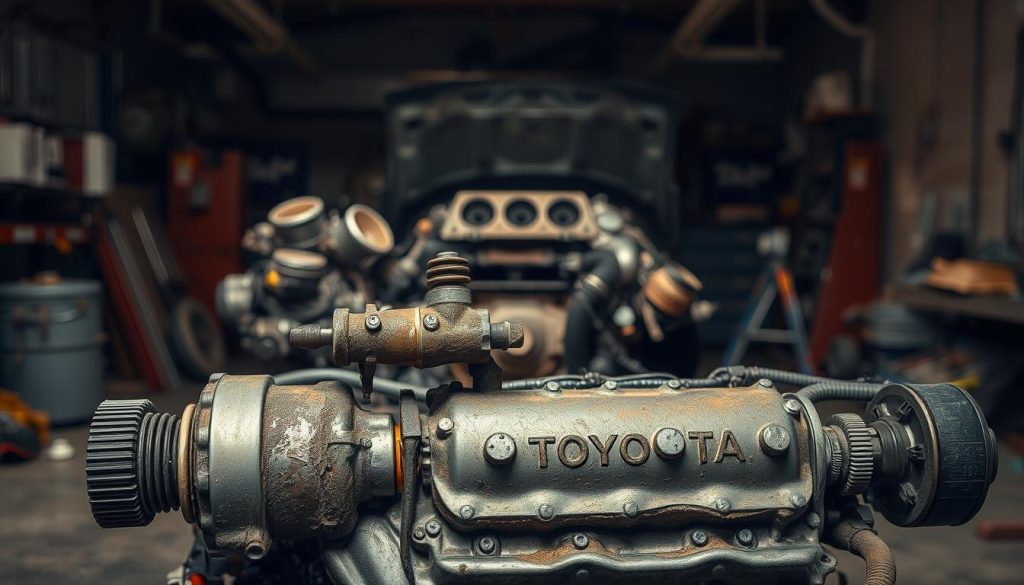
If it fails, you could face legal trouble and harm the air quality. So, it’s important to fix EGR problems quickly and keep up with regular maintenance.
In short, ignoring EGR valve issues can lead to big problems. It can cause engine damage and harm the environment. So, fixing the Toyota EGR system on time is not just a good idea. It’s necessary to keep your car running well for a long time.
Professional Help vs. DIY: Which is Better for EGR Valve Issues?
Choosing between professional help and DIY for EGR valve problems depends on the issue’s complexity and your skills. Knowing the advantages and disadvantages helps you make a better choice.
When to Seek Professional Help
For complex electronic faults or system integration issues, professional help is best. Technicians use advanced tools for *Toyota EGR valve troubleshooting*. They can fix problems that seem too hard for you.
If your car stalls, accelerates poorly, or has odd emissions after a DIY fix, get a pro’s help. They can avoid more damage.
DIY Steps You Can Take
If you’re good at fixing small car problems, you can try some *DIY EGR valve repair*. Cleaning the EGR valve is something many can do with basic tools and guides. It’s a simple task.
For basic *Toyota EGR valve troubleshooting*, like checking vacuum lines or cleaning carbon buildup, you might not need a pro. These tasks are often easy to do yourself.
Conclusion
Managing Toyota EGR valve problems is key for your car’s performance and meeting emission standards. This guide has given you a deep look into EGR valve management in Toyota cars. Regular checks and cleanings can stop carbon buildup and other issues, keeping your engine running well.
Understanding the EGR valve’s role in controlling emissions is vital. This guide helps you spot problems and fix them, whether you do it yourself or get help from a pro. Watch for signs like the check engine light and slow acceleration. Quick action can prevent big engine problems.
Preventive maintenance is essential for EGR valve care. It includes regular checks, decoding fault codes, and knowing when to call a pro. Following these steps keeps your Toyota running smoothly. Remember, taking care of your EGR valve is a must for your car’s health and performance.
FAQ
What is the EGR Valve?
The EGR (Exhaust Gas Recirculation) valve sends some exhaust gases back into the engine’s intake. This helps lower NOx emissions and improves how well the engine burns fuel.
Why is the EGR valve important for emission control?
The EGR valve lowers the engine’s combustion temperature. This reduces the formation of nitrogen oxides, major pollutants in vehicle emissions.
What types of EGR valves are used in Toyota vehicles?
Toyota cars use two main EGR valve types. Older models have vacuum-operated valves. Modern cars have digital EGR valves for better control.
What are common problems associated with Toyota EGR valves?
Common issues include carbon buildup, electronic failures, and vacuum line leaks. These problems can harm vehicle performance and increase emissions.
What are the symptoms of a failing Toyota EGR valve?
Signs include a check engine light, rough idling, poor acceleration, and high nitrogen oxide emissions.
How can you troubleshoot a malfunctioning Toyota EGR valve?
To troubleshoot, check for a check engine light, poor engine performance, and high emissions. Use OBD-II scanners and manual checks.
What tools and materials are needed to clean a Toyota EGR valve?
You’ll need EGR valve cleaner spray, screwdrivers, and a gasket kit for cleaning.
What is the process for cleaning a Toyota EGR valve?
Remove the valve, clean off carbon deposits, and then put it back. This ensures it works right.
How do you replace a faulty Toyota EGR valve?
First, diagnose the problem. Then, buy the right EGR valve. Follow a step-by-step guide for a proper fit.
What preventive maintenance can help avoid EGR valve issues?
Regular checks and cleaning can prevent carbon buildup and electronic failures. This extends the valve and engine’s life.
How do EGR valve problems impact engine performance?
Problems can lead to lower fuel efficiency, higher emissions, and engine damage if not fixed quickly.
What are common fault codes related to Toyota EGR valve issues?
Fault codes like P0401 and P0404 show EGR flow and function problems. They help find the exact issue with the EGR system.
How can Toyota EGR valves be tested?
Test them with vacuum tests and visual checks, or use diagnostic scanners for detailed insights.
How does the EGR valve interact with other engine components?
It works with the intake manifold and turbochargers. This affects engine performance and emission control.
What are the long-term consequences of ignoring EGR valve issues?
Ignoring problems can cause severe engine wear, engine failure, and failing emission tests. Quick action is key.
When should you seek professional help for EGR valve issues?
Get professional help for complex electronic faults or system integration issues. DIY cleaning is okay for simple tasks, but experts should handle complex problems.

